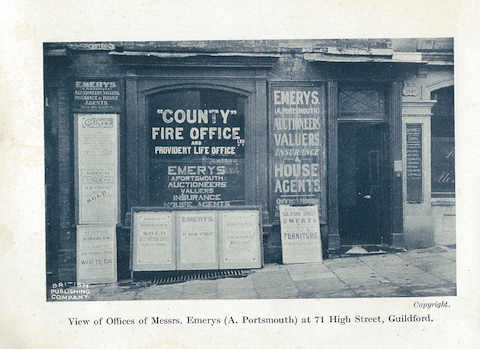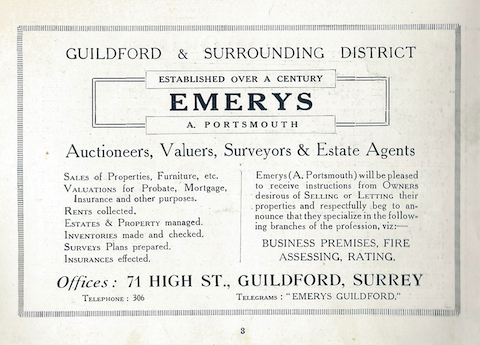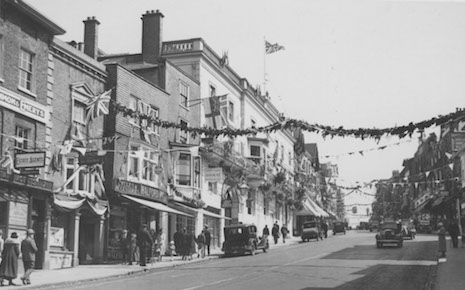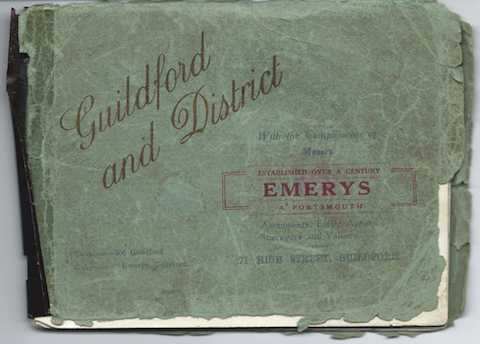 Abraham Lincoln
If given the truth, the people can be depended upon to meet any national crisis...
Abraham Lincoln
If given the truth, the people can be depended upon to meet any national crisis...
 Guildford news...
for Guildford people, brought to you by Guildford reporters - Guildford's own news service
Guildford news...
for Guildford people, brought to you by Guildford reporters - Guildford's own news service
Guildford’s 20th Century House-Building Boom And Clarke Gammon Was There At The Start
Published on: 16 Nov, 2015
Updated on: 16 Nov, 2015
By David Rose
Soon after the First World War house building picked up in the Guildford area.
The borough desperately needed new homes: for young men who had returned from the war and who were getting married, for employees of expanding firms such as Dennis Bros, and professional people looking to move to a desirable town close to the countryside.
In the 1920s and on through the 1930s right up until the outbreak of the Second World War, Guildford expanded in all directions.
Development that took place soon after the Great War ranged from council housing at Shepherds Hill in Stoughton, to upmarket houses on the Edgeborough Estate, off the Epsom Road.

Advertisement that appeared in a guidebook entitled Guildford and District, with compliments from estate agents Emerys in 1923.
For the buying and selling of houses, Guildford required professional auctioneers and estate agents. And there were not many of them in those days, even by 1939. That year’s edition of the Kelly’s Directory of Guildford and Godalming reveals there were: Clarke, Gammon & Emerys; Crowe, Bates & Weekes; Curtis & Co; Heath & Salter; Moldram & Co; Richard Rowbotham & Co, auctioneers; Alfred Savill & Sons; Shaw & Elder; and Wallis & Wallis.
Of those, Clarke Gammon was established in Guildford High Street by Sydney Clarke and Frank Gammon in 1919. They later merged with Emerys, that had offices in Bridge Street and also High Street.
In 1923 Emerys issued a complimentary guide to Guildford. It may have been desgined to give to those who were looking to relocate to the county town with acres of countryside all around.

The booklet features a photo of Emerys office in the High Street. This is where later Clarke Gammon & Emerys (later still Clarke Gammon) was based. To the right was then a branch office and depot of Maidstone brewers Fremlins. The stonework surround with a date of 1889 remains to this day and is now the High Street entrance to Phoenix Court.

A page in the booklet gives details about Emerys. It appeared to have been founded in the early 19th century and in 1923 was owned by someone by the name of A. Portsmouth. Note under the services offered: ‘rents collected’. This would be ‘letting agents’ today.
The merger of Clarke Gammon and Emerys had certainly taken place by 1935, as that in year’s Lasham’s Directory of Greater Guildford it lists the firm of Clarke Gammon & Emerys at 71 and 188 High Street. There was a different numbering system back then (changed in about 1961).
No. 71 High Street was on the north side (later re-numbered 45, 47 and 49), and next to today’s entrance to Phoenix Court. What was No. 188 is now Upper High Street, on the north side and somewhere between Alexander Terrace (where the Raddison Blu Edwardian Hotel is) and Eastgate Gardens.
Clarke Gammon & Emerys expanded with branches in Godalming, Haslemere and Hindhead, as a copy of a complimentary Guildford street map shows.

The map has seen some use in its time! As can be seen by the sticky tape! Click to enlarge in a new window to have a closer look.
Although the map is not dated, its age can be estimated by looking at the roads shown on it. For example, off Rydes Hill Road on the far left not marked are Pennings Avenue or Rydes Avenue. These were built in the mid-1930s.

Enamel on iron advertising sign used by Clarke Gammon & Emerys at its Godalming branch. It is also likely to date to the 1930s.
What has recently come to light is a fairly large enanel advertising sign for Clarke Gammon & Emerys – a forerunner of today’s lightweight ‘for sale’ and ‘to let’ signs. It refers to its Godalming branch and is thought to date to the 1930s.

Guildford High Street pictured in 1935 at the time of George V’s silver jubilee. On the far left is the office of Clarke Gammon & Emerys.
The firm was trading by that name in Guildford at the time of the 1974 Kelly’s Directory of Guildford and Godalming. Tony Jamison, senior partner at today’s Clarke Gammon Wellers believes the firm reverted to the name Clarke Gammon in about the mid-1970s.
Today’s name came about in 2004. Weller Eggar was a once well known estate agent and auctioneer in the local area. In fact, go back to the 1930s and Weller Son & Grinstead were agricultural auctioneers based at Guildford’s cattle market, then in Woodbridge Road.
In latter years, Weller Eggar had its estate agent offices at 4 Quarry Street, Guildford (where Clarke Gammon Wellers is now), while its auctioneering side was based at the cattle market at Slyfield Green, that had moved there from Woodbridge Road.
After the 2004 changes, the Wellers auctioneering side of the business became a separate company and is now based in Chertsey.
Today, Clarke Gammon Wellers has offices in Guildford, Shere, Haslemere and Liphook.
Responses to Guildford’s 20th Century House-Building Boom And Clarke Gammon Was There At The Start
Leave a Comment Cancel reply
Please see our comments policy. All comments are moderated and may take time to appear. Full names, or at least initial and surname, must be given.
Click on cartoon for Dragon story: Public Asked for Views on SCC’s Proposal for Reduced Speed Limits






Recent Articles
- Mayor of Guildford Drops In on One of His Chosen Charities
- The Church’s Message Is As Relevant As Ever, Says Ash’s Retiring Priest
- CANCELLED: Have a Blooming Picnic – June 7
- Eight Out of Ten PIP Claimants in Guildford Face Cuts to Their “Lifeline”
- Waverley’s New Discretionary CIL Review Scheme To Be Revealed Soon
- Council Accepts Responsibility of Meeting Farnham Museum’s Ballooning Repair Costs
- Notice: Cut It Out!
- Stoke Park Was Bought 100 Years Ago with Plans for a Public Open Space and Houses!
- Dragon Review: The Pajama Game – Yvonne Arnaud Theatre
- A Hidden Gem in the Hills: Michelin-Backed William IV Pub Brings Refined Dining to Albury


Recent Comments
- Bernard Quoroll on Community Councils Proposed to Maintain Local Representation
- John Lomas on A Look Back at Perry Hill’s New Inn and a Family That Once Ran It
- Robert Garbolinski on Dragon Review: The Pajama Game – Yvonne Arnaud Theatre
- Philip Camp on A Look Back at Perry Hill’s New Inn and a Family That Once Ran It
- RWL Davies on Community Councils Proposed to Maintain Local Representation
- Stephen Spark on Major Disruption on the Railway During Hot Day in 1900
Search in Site
Media Gallery
Dragon Interview: Local Artist Leaves Her Mark At One of England’s Most Historic Buildings
January 21, 2023 / No Comment / Read MoreDragon Interview: Lib Dem Planning Chair: ‘Current Policy Doesn’t Work for Local People’
January 19, 2023 / No Comment / Read MoreA3 Tunnel in Guildford ‘Necessary’ for New Homes, Says Guildford’s MP
January 10, 2023 / No Comment / Read More‘Madness’ for London Road Scheme to Go Ahead Against ‘Huge Opposition’, Says SCC Leader
January 6, 2023 / No Comment / Read MoreCouncillor’s Son Starts Campaign for More Consultation on North Street Plan
December 30, 2022 / No Comment / Read MoreCounty Council Climbs Down Over London Road Works – Further ‘Engagement’ Period Announced
December 14, 2022 / No Comment / Read MoreDragon Interview: GBC Reaction to the Government’s Expected Decision to Relax Housing Targets
December 7, 2022 / No Comment / Read MoreHow Can Our Town Centre Businesses Recover? Watch the Shop Front Debate
May 18, 2020 / No Comment / Read More








John Lomas
November 17, 2015 at 2:01 pm
Regarding the date of the street map.
Roger Edwards’ article “Memories of Wartime: Stoughton 1944” in a Through Time article on the Dragon in 2013 has a photo of houses at the top of Byrefield Road with the road surface not yet completed.
He dates it as about 1935.
We lived lower down and my parents told me that the houses at the bottom of the road were built in about 1934-35.